Portable Microscopes
by Mike Dingley, Australia
Click on each microscope to
view a larger image, and use the Web browser's back button to
return to article.
See footnote if problems viewing the larger images.
Copyright
notice
As a collector of portable, folding, pocket,
field-type microscopes I thought that, as I am constantly amazed
at the numbers that have been produced, I would share with you a
few models old and new from my collection.
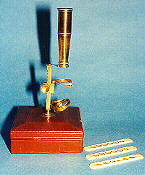 1. CARY/GOULD
Type. (New Improved Pocket Microscope). Made around 1820
with three objective lenses, a live-box, three ivory (or bone)
sliders each containing six dry specimens, forceps and a needle
probe. All stored in a red leathered box. The lid of the storage
box contains a boss into which is screwed the base of the
microscope pillar.
1. CARY/GOULD
Type. (New Improved Pocket Microscope). Made around 1820
with three objective lenses, a live-box, three ivory (or bone)
sliders each containing six dry specimens, forceps and a needle
probe. All stored in a red leathered box. The lid of the storage
box contains a boss into which is screwed the base of the
microscope pillar.
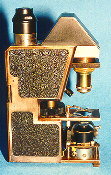 2.
GROOM'S HOME-MADE PORTABLE. This microscope was made in
1977 by Norman Groom and he described it in an article in Microscopy
1978, Vol. 33, part 6, pp.365-372. It contains a Meopta 10X
eyepiece and an unknown 10X eyepiece with a graticule. Present
are a Russian 3.7X, N.A. 0.11 objective and E. Leitz #3
objective. Built-in transmitted and incident light sources
(powered by internal batteries), condenser, aperture diaphragm
and filter holder containing light green, open, dark ground and
polarising filters. A separate analyser is fitted in the wooden
case as is a prepared slide of arranged butterfly scales and an
objective sleeve.
2.
GROOM'S HOME-MADE PORTABLE. This microscope was made in
1977 by Norman Groom and he described it in an article in Microscopy
1978, Vol. 33, part 6, pp.365-372. It contains a Meopta 10X
eyepiece and an unknown 10X eyepiece with a graticule. Present
are a Russian 3.7X, N.A. 0.11 objective and E. Leitz #3
objective. Built-in transmitted and incident light sources
(powered by internal batteries), condenser, aperture diaphragm
and filter holder containing light green, open, dark ground and
polarising filters. A separate analyser is fitted in the wooden
case as is a prepared slide of arranged butterfly scales and an
objective sleeve.
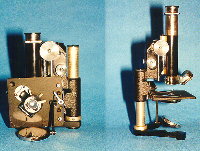 3. REICHERT
'HEIMDAL' FIELD MICROSCOPE. Made around 1930. Number
190268. Contains 5X and 10X Reichert oculars, ocular micrometer,
Abbe optical condenser, 100X Reichert objective and funnel stop.
Attached to the inside of the storage box are two clips each
containing tiny ground-glass stoppered bottles (for immersion oil
and solvent e.g. xylene). All packed into an aluminium case which
is in turn packed in to an outer leather case with strap for
carrying. It resembles a binocular case. A similar instrument can
be found in an article by D.B. Payne, 'The Reichert 'Heimdal'
Field Microscope after F.K. Reinsch'. In Microscopy
1977, vol. 33, part 4, pp.201-206. The two pictures show the
instrument folded (when stored) and opened up for use.
3. REICHERT
'HEIMDAL' FIELD MICROSCOPE. Made around 1930. Number
190268. Contains 5X and 10X Reichert oculars, ocular micrometer,
Abbe optical condenser, 100X Reichert objective and funnel stop.
Attached to the inside of the storage box are two clips each
containing tiny ground-glass stoppered bottles (for immersion oil
and solvent e.g. xylene). All packed into an aluminium case which
is in turn packed in to an outer leather case with strap for
carrying. It resembles a binocular case. A similar instrument can
be found in an article by D.B. Payne, 'The Reichert 'Heimdal'
Field Microscope after F.K. Reinsch'. In Microscopy
1977, vol. 33, part 4, pp.201-206. The two pictures show the
instrument folded (when stored) and opened up for use.
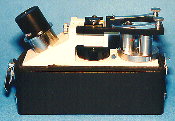 4.
SWIFT FM-31. W10x eyepiece 4X, 10X, 40X and 40X LWD
objectives with external battery lamp (not illustrated) and
leather case. The eyepiece tube is pulled out to its maximum for
use and pushed in for storage. The objectives are non-RMS
threaded and are screwed in to a revolving turret below the plain
stage. There is a tripod mount socket in the base for attaching
the instrument to a tripod when required. Slides are normally
viewed in an upside down position but can be used the correct way
up (as can thick based vessels such as Petri dishes) when long
working distance (LWD) objectives are used.
4.
SWIFT FM-31. W10x eyepiece 4X, 10X, 40X and 40X LWD
objectives with external battery lamp (not illustrated) and
leather case. The eyepiece tube is pulled out to its maximum for
use and pushed in for storage. The objectives are non-RMS
threaded and are screwed in to a revolving turret below the plain
stage. There is a tripod mount socket in the base for attaching
the instrument to a tripod when required. Slides are normally
viewed in an upside down position but can be used the correct way
up (as can thick based vessels such as Petri dishes) when long
working distance (LWD) objectives are used.
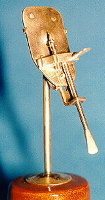 5.
LEEUWENHOEK REPLICA. This copy of Leeuwenhoek's simple
microscope was made by a friend of mine in 1996. It is made
entirely from silver and does have a small glass lens for
observing specimens.
5.
LEEUWENHOEK REPLICA. This copy of Leeuwenhoek's simple
microscope was made by a friend of mine in 1996. It is made
entirely from silver and does have a small glass lens for
observing specimens.
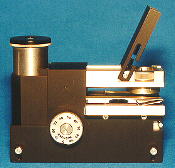 6.
McARTHUR MICROSCOPE. This is one of several that I have
in my collection. It was made by W. Kirk & Sons around 1988.
It is a biological model with 10X eyepiece and 10X and 40X
objectives. It also has a mirror and condenser with an iris
diaphragm. Fine focus control is all that is required as slides
are seated on the stage upside down and focus is achieved through
the thin cover slip.
6.
McARTHUR MICROSCOPE. This is one of several that I have
in my collection. It was made by W. Kirk & Sons around 1988.
It is a biological model with 10X eyepiece and 10X and 40X
objectives. It also has a mirror and condenser with an iris
diaphragm. Fine focus control is all that is required as slides
are seated on the stage upside down and focus is achieved through
the thin cover slip.
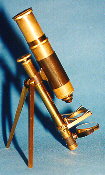 7.
MOGINIE-TYPE. See page 109 of 'The Great Age of the
Microscope' by G. L'E Turner. This instrument is signed 'John
Browning, 63 Strand, London' and was made between 1872 and 1897.
The mirror is a single concave and the plain stage has two clips.
The collar that holds the body tube is in dark lacquer as is the
mirror stirrup. Fine focussing is achieved by a knob actuating a
screw that moves the stage up and down. It has one ocular and two
objectives (½" and 1") each with RMS threads. The
instrument resides in a plush-lined wooden box with blue silk
lining the lid. The outside of the box is covered with embossed
paper emulating the appearance of Morocco leather.
7.
MOGINIE-TYPE. See page 109 of 'The Great Age of the
Microscope' by G. L'E Turner. This instrument is signed 'John
Browning, 63 Strand, London' and was made between 1872 and 1897.
The mirror is a single concave and the plain stage has two clips.
The collar that holds the body tube is in dark lacquer as is the
mirror stirrup. Fine focussing is achieved by a knob actuating a
screw that moves the stage up and down. It has one ocular and two
objectives (½" and 1") each with RMS threads. The
instrument resides in a plush-lined wooden box with blue silk
lining the lid. The outside of the box is covered with embossed
paper emulating the appearance of Morocco leather.
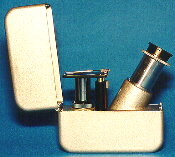 8.
TIYODA POCKET MICROSCOPE V-II. This instrument is
contained within a grey metal case with a hinged lid. It has a
10X eyepiece and a single objective of 20X magnification (giving
a total magnification of 200X) and NA 0.40. Purchased new in 1995
the metal lid, when closed, forms half of the case. When used the
lid is opened and the eyepiece tube is pulled out to its maximum
to give 160mm tube length. There is no condenser and focussing is
controlled by a knurled ring which, when turned, raises and
lowers the plain stage.
8.
TIYODA POCKET MICROSCOPE V-II. This instrument is
contained within a grey metal case with a hinged lid. It has a
10X eyepiece and a single objective of 20X magnification (giving
a total magnification of 200X) and NA 0.40. Purchased new in 1995
the metal lid, when closed, forms half of the case. When used the
lid is opened and the eyepiece tube is pulled out to its maximum
to give 160mm tube length. There is no condenser and focussing is
controlled by a knurled ring which, when turned, raises and
lowers the plain stage.
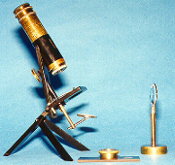
9. R&J BECK. "BABY
LONDON". Serial number 40149. Stand only consists
of a stage with two clips, concave mirror and two draw tubes. The
legs fold up and the instrument fits in to a blue velvet-lined
case measuring 144mm X 105mm X 42mm. An accessory case
accompanies this and contains the following accessories:
live box,
32mm X4 NA 0.12 objective,
16mm X10 NA 0.17 objective
42mm X6 eyepiece
17mm X15 eyepiece
spot lens and condenser,
bull's eye condenser on a brass stand
three packets of plain and single concave
slides.
Editor's notes:
Click here to view an original 1921 advert for the 'Baby London'
microscope and price list.
Microscopy, referred
to in the text, is the twice yearly journal of the Quekett
Microscopical Club.
Footnote:
If you don't see the larger image when clicking the drawings,
check that your Web browser has a jpeg image file viewer
installed. For Netscape in the menu Options / General Preferences
/ Helpers go down the menu to 'image/ jpeg' file types, click on
it and either activate 'Use browser' to view them (the quickest
and easiest method), or enter the path and exe filename of
software on your local PC that can view jpeg eg a Photoimage
editor. Return to top of
article.
Copyright
notice: The images are © Mike Dingley. All Micscape
images can be downloaded for personal use only, or for use in
small projects in clubs or schools. No commercial re-publication
or distribution of the images is allowed without seeking
permission from Mike Dingley. Return to top of article.
© Microscopy UK or their
contributors.
Please report any Web problems
or offer general comments to the Micscape Editor,
via the contact on current Micscape Index.
Micscape is the on-line monthly
magazine of the Microscopy UK web
site at Microscopy-UK
WIDTH=1
© Onview.net Ltd, Microscopy-UK, and all contributors 1995 onwards. All rights
reserved. Main site is at www.microscopy-uk.org.uk with full mirror at www.microscopy-uk.net.
 1. CARY/GOULD
Type. (New Improved Pocket Microscope). Made around 1820
with three objective lenses, a live-box, three ivory (or bone)
sliders each containing six dry specimens, forceps and a needle
probe. All stored in a red leathered box. The lid of the storage
box contains a boss into which is screwed the base of the
microscope pillar.
1. CARY/GOULD
Type. (New Improved Pocket Microscope). Made around 1820
with three objective lenses, a live-box, three ivory (or bone)
sliders each containing six dry specimens, forceps and a needle
probe. All stored in a red leathered box. The lid of the storage
box contains a boss into which is screwed the base of the
microscope pillar.






